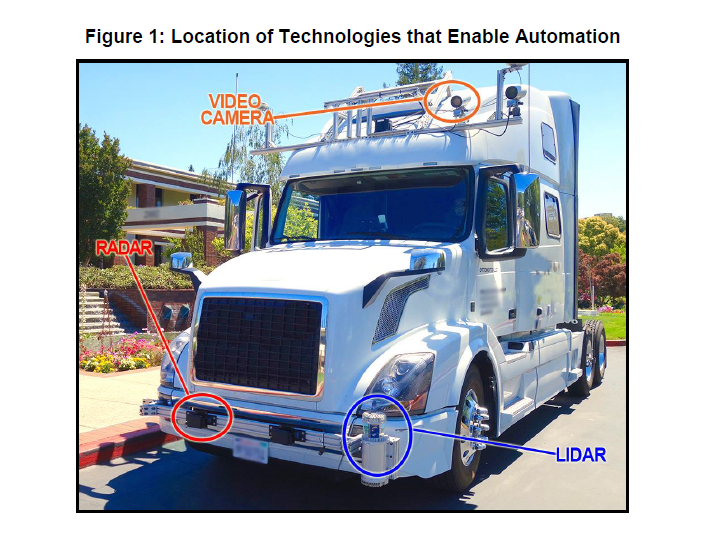
Full Self-Driving Trucks Likely To Be Ready Before the Infrastructure and Regulations Can Catch Up
posted in Alerts, Blog, Uncategorized by Brian Gray
Full Self-Driving Trucks Likely To Be Ready Before the Infrastructure and Regulations Can Catch Up
Author: Dave Gray, President of Glostone Trucking Solutions
Today. Tomorrow. The Future.

According to Daimler, trucks transported about 70 percent of all freight in the U.S. in 2012 and by 2050 the global trucking industry is expected to triple. However, with increased freight opportunities comes increasing congestion, pollution, and potential accidents.
Autonomous trucks are coming and most of the technology to automate commercial driving has already been created. Even Nevada became the first state in the country to create special regulations for the use of self-driving vehicles. Nevada is anticipating the continued automation of the trucking industry and has created regulations to govern the use of automated vehicles. It is likely that self-driving trucks will be ready for service before the infrastructure and regulations can catch up.
But there are certain “levels” of autonomy before full self-driving can be achieved.
NHTSA’s 5 Levels of Automation in Trucks
I had the opportunity to attend the International Registration Plan Inc’s (IRP) annual meeting in Oklahoma City in early May. As a part of industries guidance at this particular meeting, Bob Pitcher, VP of State Laws for the American Trucking Associations, did a presentation on the current developments in automated driving for commercial vehicles and how the technology might change the trucking industry. Mr Pitcher referenced the National Highway Transportation Safety Administrations (NHTSA) 5 Levels of Automation in trucks and applied the driver interaction required at each level:
Level 0: No Automation Hands-on, feet-on, eyes-on, brain-on
Level 1: Function-specific Hands-off, feet-on, eyes-on, brain-on
Level 2: Combined Functions Hands-off, feet-off, eyes-on, brain-on
Level 3: Limited Self-Driving Hands-off, feet-off, eyes-off, brain-on (Inspiration)
Level 4: Full Self-Driving Hands-off, feet-off, eyes-off, brain-off (OTTO)
And finally, there is Level 5, which is a “Full Self-Driving” truck with no driver present at all.
Where We Are Today
Level 2 trucks are a common sight on the road today. The trucks you see on the road are often equipped with combined function automations, such as automatic transmissions, adaptive cruise control, lane departure warnings, electronic stability control, and more.
Current technological development has moved to and is generally available now for level 3 truck automation as evidenced by the successful truck “platooning” testing that has been demonstrated. The practicality of platooning remains to be seen. Platooning technology will only be applicable to certain types of operations and testing has yet to identify the cost savings involved. Other developments in Level 3 technology include vehicle-to-vehicle machine communication and crash avoidance systems.
Daimler officials said they have already logged over 10,000 miles testing the Inspiration truck, enough to make them feel confident it can operate safely on public roads. Trucks with Level 3 automation technology, like Inspiration, would still require driver input for navigation conditions that the computer cannot interpret, such as when white line stripes are not visible.
OTTO has since demonstrated a system that converts a standard truck into an L4 autonomous truck, thus allowing a driver to be away from the steering wheel in certain driving conditions. In the first real-world commercial use of autonomous trucking, in October, some 45,000 cans of Budweiser beer arrived to a warehouse after traveling over 120 highway miles in a self-driving truck with no driver at the wheel, executives from Uber and Anheuser-Busch said.
What may the Future Hold?
According to ATRI, IHS Automotive states that “autonomous truck sales could reach 60,000 annually by 2035 [or] 15 percent of sales for trucks in the big Class 8 weight segment.” There are currently 3.46 million Class 8 trucks in the U.S.; if hypothetically 60,000 autonomous trucks were added annually starting today (instead of 20 years from now), it would be more than five years before autonomous trucks made up 10 percent of the total fleet. Thus, the IHS prediction does not see rapid adoption in the shorter term.
The ATRI report also discusses that the cost of trucks with autonomous systems will be greater than a standard truck. Since there are no commercially available systems at the time of publication, estimates are relied on for this report. For the OTTO retrofit and the Freightliner Inspiration, a figure of $30,000 per truck automated systems cost has been published. One report looked at costs incrementally, and estimated that additional costs per truck for hardware and software would be as follows:
- L3: $13,100 added to truck price
- L4: $19,000 added to truck price
- L5: $23,400 added to truck price
These costs are mainly related to software, and do not include inspection, maintenance or updates. As these technologies become more widely adopted, prices are likely to decrease. At the moment due to numerous unknowns related to software investment needs and industry regulations, an accurate return-on-investment (ROI) analysis is not possible.
Will We Be Ready For the Full Self-Driving Trucks?


ATRI Autonomous Vehicle Technology Impacts on the Trucking Industry Report Nov 2016 – Table 4
Today’s developers have already designed much of the technology required to move to Level 4 automation and the self-driving truck. These developers expect that in the next 24 to 36 months, we will have the technology to the point where the self-driving truck could be put into service.
However, just because the technology will be available on the trucks does not mean self-driving trucks will be allowed on the road. Self-driving trucks will require redesigned highways, revised regulations, new traffic rules, enforcement, and enhanced safety, both physical and cyber, that regulators will need to deal with first. It’s safe to say the “self-driving truck” will be ready long before the infrastructure, the government, and the public accept the presence of un-attended vehicles on the road.







